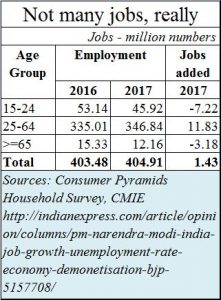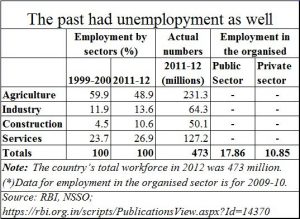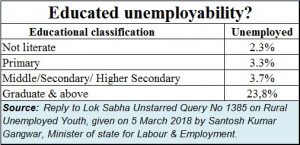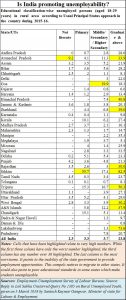https://www.moneycontrol.com/news/india/comment-the-governments-jobs-problem-is-serious-but-there-are-solutions-at-hand-2567017.html
Yes there is unemployment; but is the government serious about redressing it?
This government, if one goes by CMIE estimates, could create only 1.43 million jobs in 2017. This is contrary to what the government wants to claim
RN Bhaskar — May 11, 2018
This government, if one goes by CMIE estimates, could create only 1.43 million jobs in 2017. This is contrary to what the government wants to claim. This number is far less than the 12 million jobs the government must create each year if it has to keep the economy growing healthily.
 The 12 million number too is a result of a very simple calculation. India’s population of 1.3 billion has been growing at 1.9% a year. That gives us a population growth of 24.7 million annually. Assuming 50% of this population chooses not to work – many girls still prefer becoming homemakers; some people may decide to go into business; some may do nothing –you still get a number of 12 million who will need jobs. Yes, some of the youth may go overseas; some may opt for college education and so on. But then this is a recurring phenomenon. The incremental population seeking jobs will remain at around 12 million a year.
The 12 million number too is a result of a very simple calculation. India’s population of 1.3 billion has been growing at 1.9% a year. That gives us a population growth of 24.7 million annually. Assuming 50% of this population chooses not to work – many girls still prefer becoming homemakers; some people may decide to go into business; some may do nothing –you still get a number of 12 million who will need jobs. Yes, some of the youth may go overseas; some may opt for college education and so on. But then this is a recurring phenomenon. The incremental population seeking jobs will remain at around 12 million a year.
 Obviously, the poor job creation would pose a huge embarrassment for the government. In fact, that was the accusation that this BJP itself had levelled against the previous government and promised the redress the situation. Even then, there was little job creation.
Obviously, the poor job creation would pose a huge embarrassment for the government. In fact, that was the accusation that this BJP itself had levelled against the previous government and promised the redress the situation. Even then, there was little job creation.
If jobs creation falters for almost 6-8 years in a row, it means that there is something structurally wrong with the economy. It needs to be set right. Quickly.
Huge data gaps
 One problem is that the data on employment has been rather sketchy for decades. Even today, the government’s own ministry of statistics and programme implementation has data for different organisations, but no aggregated data can be found (http://mospi.nic.in/statistical-year-book-india/2017/201). So you have data for the railways, factories, mines, shops & establishments and for plantations. But not for the entire country. After 70 years of independence, surely this is a crucial input every government needs!
One problem is that the data on employment has been rather sketchy for decades. Even today, the government’s own ministry of statistics and programme implementation has data for different organisations, but no aggregated data can be found (http://mospi.nic.in/statistical-year-book-india/2017/201). So you have data for the railways, factories, mines, shops & establishments and for plantations. But not for the entire country. After 70 years of independence, surely this is a crucial input every government needs!
 In June 2017, the government announced that the labour bureau of the government and the NSSO (National Sample Survey Office — http://www.mospi.gov.in/national-sample-survey-office-nsso) would continue to work together on labour surveys. The plan was to work on gathering information on a large scale and with different methodologies. These would be decided after a task force on employment submits its report to the government. And instead of doing such surveys intermittently, the new plans include doing such surveys every year. The sooner, the better.
In June 2017, the government announced that the labour bureau of the government and the NSSO (National Sample Survey Office — http://www.mospi.gov.in/national-sample-survey-office-nsso) would continue to work together on labour surveys. The plan was to work on gathering information on a large scale and with different methodologies. These would be decided after a task force on employment submits its report to the government. And instead of doing such surveys intermittently, the new plans include doing such surveys every year. The sooner, the better.
 NSSO has also launched a new employment-unemployment survey, namely, Periodic Labour Force Survey (PLFS). PLFS is a continuous/regular survey for generating estimates of various labour force indicators on a quarterly basis for urban areas and annual basis for both rural and urban areas, at State/UT and all-India level. That is a welcome announcement.
NSSO has also launched a new employment-unemployment survey, namely, Periodic Labour Force Survey (PLFS). PLFS is a continuous/regular survey for generating estimates of various labour force indicators on a quarterly basis for urban areas and annual basis for both rural and urban areas, at State/UT and all-India level. That is a welcome announcement.
Unemployment or unemployability?
There is yet another cause for concern. On March 5, 2018, the government gave out data before the Lok Sabha (see the two tables) which pointed to the growing incidence of educated unemployment. The data suggested that unemployment was more rampant among the educated that among the uneducated.
The causes could be many. And some possible answers are available if one looks at the state-wise numbers which cumulatively add up to the numbers given above.
In most cases, it would appear that unemployment among the educated was on account of not enough jobs being created in the state. Thus, even in Kerala, a state with the highest literacy rates, the incidence of educated unemployment is high.
Secondly, the data is for rural employment only. It is this kind of sketchy information that blurs the actual state of unemployment in the country.
Then there are states like Arunachal Pradesh where the standards of education are higher than in most states, but where industrialization hasn’t been pushed for decades. And most youth do not wish to leave their home towns either.
But the most probable cause could be unemployability. This is what the latest ASER 2017 (Annual Status of Education Report brought out by NGO Pratham) report suggests (http://img.asercentre.org/docs/Publications/ASER%20Reports/ASER%202017/aser2017nationalfindings.pdf), When it comes to “the current status of foundational skills”, almost 25% of the age group 14-18 years cannot read basic text fluently in their own language. More than half of them struggle with simple division – 3 digit by one digit). Only 43% can do such sums correctly.
This appears to tie in with reports from both McKinsey and Nassom that only 25% of the applicants are employable.
The educated unemployed pose two major problems. First, they represent the time and money lost in going through a wasteful educational grind. The money lost belongs both to the state and to the students’ families. The child could have been more useful at home or on the farms rather than in school and college.
Second, since the child is now ‘educated’ his expectations of a good employment opportunity are also greater than that of a student who has not studied. But when aspirations do not meet competence standards, disgruntlement is just a step away. That dissatisfaction can be extremely corrosive at any workplace, and can lead to other attendant problems.
Solutions exist
It is not that solutions do not exist. But they require political will. And this is something that appears to be missing even with a ‘strong’ government like the present one.
One solution could be adopting the decentralised cluster approach for rooftop solar (http://www.moneycontrol.com/news/business/dear-pm-modi-heres-how-bureaucrats-are-planning-to-scuttle-your-rooftop-solar-employment-plans-2468501.html). But that would require keeping politicians away from announcing power subsidies, and also permitting the flexibility of abetting power theft. Decentralised clusters can work only if the distribution part of the business is left to private entrepreneurs. But that would take away the powers of both bureaucrats and politicians. It appears that permitting unemployment is a better option for them.
A second solution would lie in using the same decentralised cluster approach to promote methane generation – preferably by the same entrepreneur who runs the rooftop solar business as well for that cluster https://www.moneycontrol.com/news/business/economy/comment-the-spinoff-from-swachh-bharat-wealth-from-waste-could-be-big-sht-2556797.html. The job and wealth potential of methane generation is tremendous. And it would help India save enormous amounts on foreign exchange and pollution as well.
There is a third option as well. It is looking at affordable housing with the same seriousness that Iran showed in the 1980s till the last decade (https://www.moneycontrol.com/news/business/between-smiles-and-sorrows-world-bank-forecasts-india-gdp-rise-but-raises-unemployment-concerns-2558785.html). But affordable housing does not work only by announcing schemes. It does not work with building just around 1,000-5,000 houses outside each city. To make it work you need to create a few million houses near existing cities each year. That will prevent the entire exercise from becoming a blackmarket operation. This is because the requirement for affordable houses is well over 19 million. This was on the basis of data compiled in 2012. Today, the demand could be well over 22 million.
And it requires a zero tolerance for slums, which are useful to politicians for creating votebanks through demographic tinkering. That is something real estate speculators, politicians and privileged bureaucrats do not like. Otherwise, if such a scheme is taken up earnestly even today, India can create a few million houses before election dates are announced.
Affordable housing creates huge employment opportunities for unskilled workers, skilled workers like plumbers and electricians, and highly skilled professionals like surveyors, architects and city planners.
These are quick solutions. But a long-term solution would require an overhaul of the educational system as it exists today – beginning with primary and then with secondary education. But more on that later.
Thus, if the government wants, the unemployability problem can be addressed quickly. But it is solvable by adopting Indian solutions to a peculiar problem that India faces.
But does Modi have the political will?











































COMMENTS